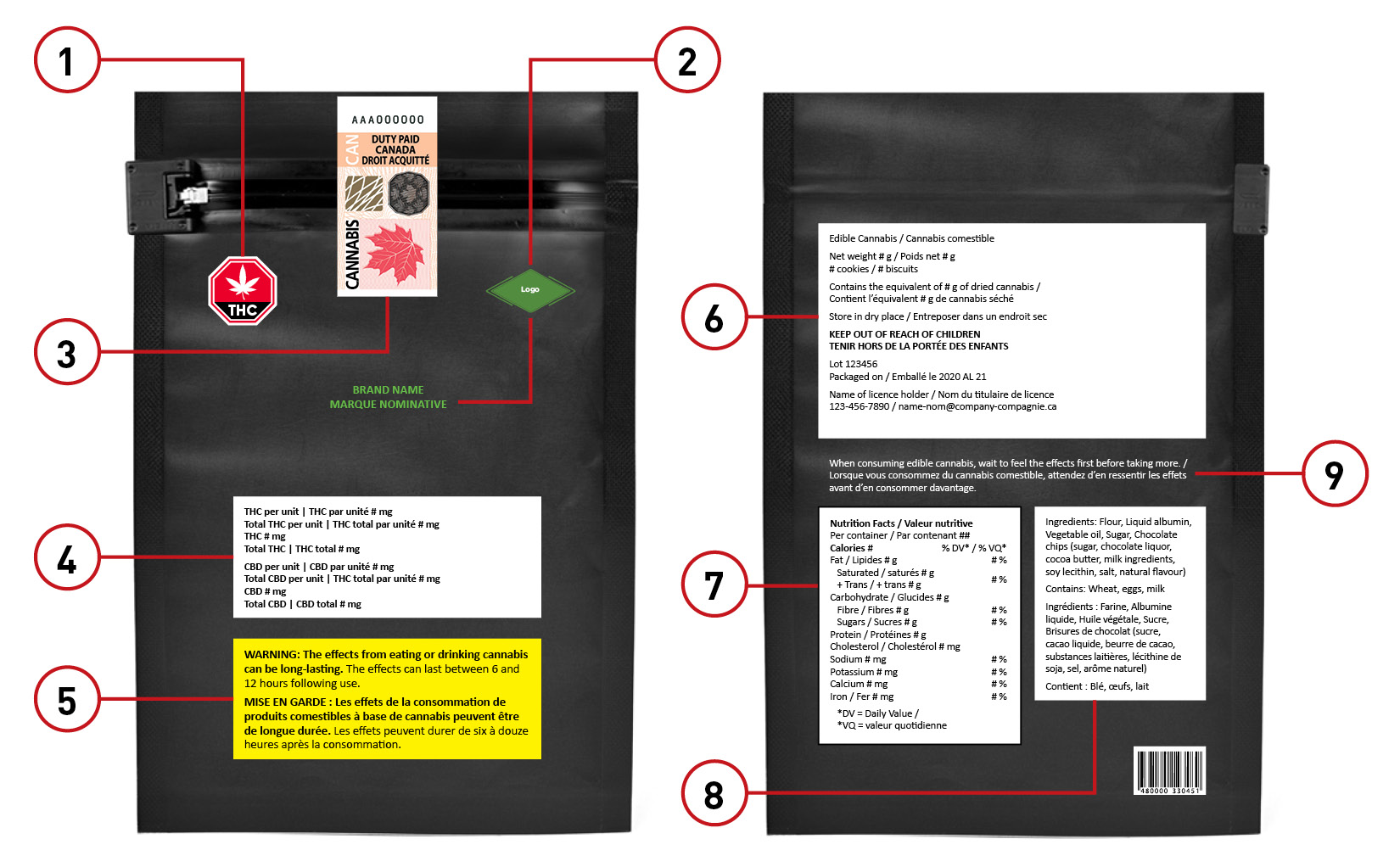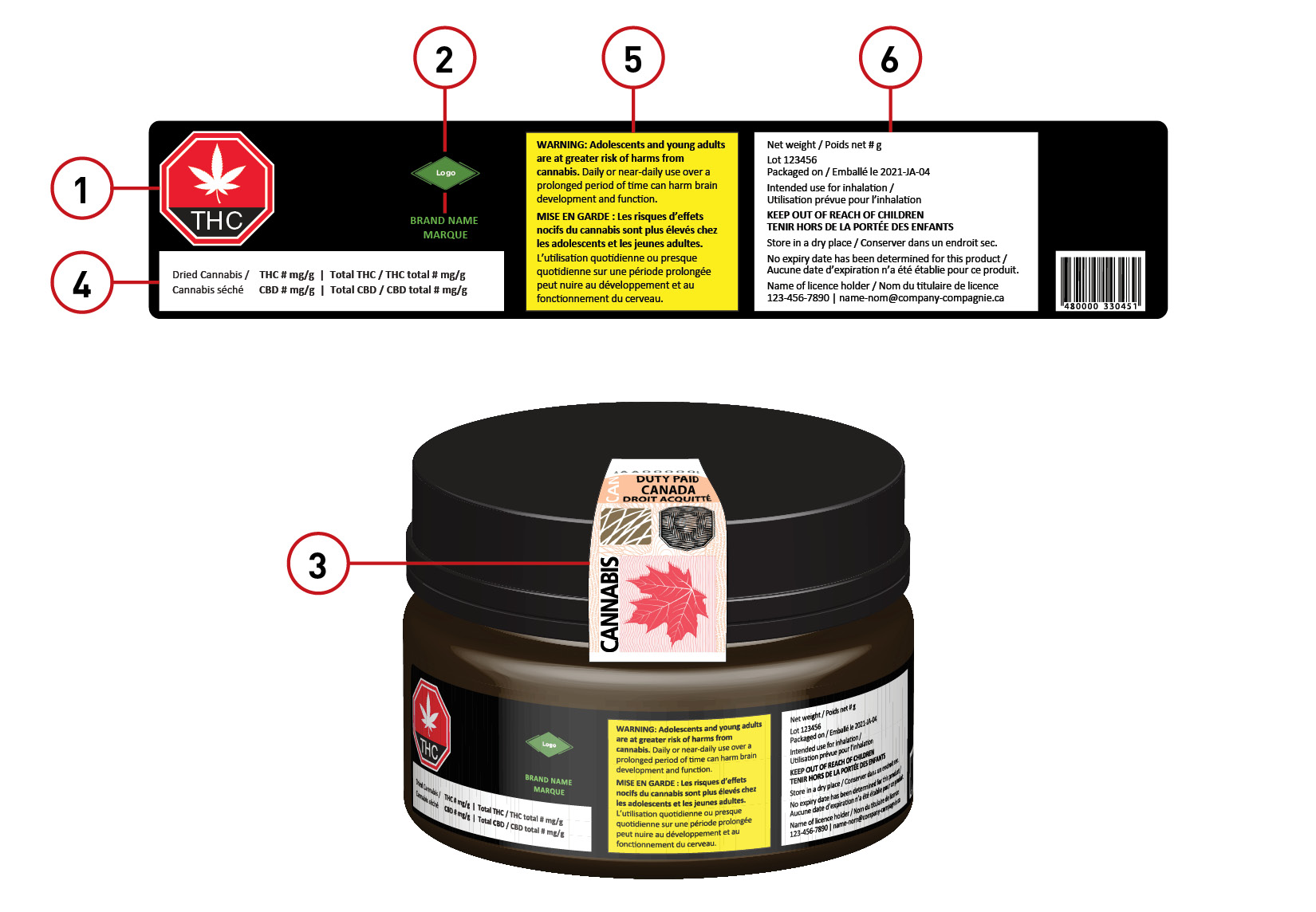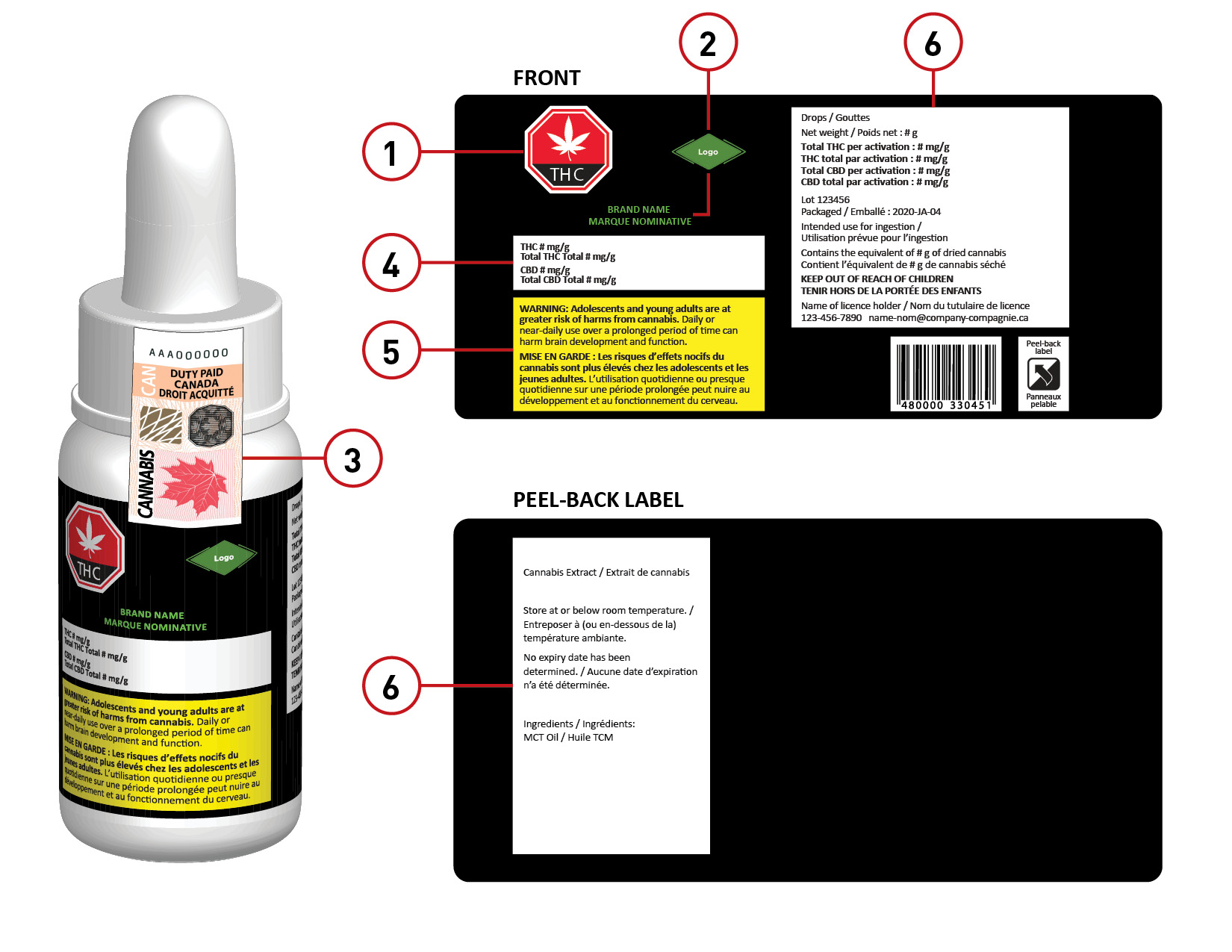How to read and understand a cannabis product label
Important: Effective March 12, 2025, Health Canada announced the coming into force of the Regulations Amending Certain Regulations Concerning Cannabis (Streamlining of Requirements). This web page will be updated in the coming months to reflect the amended regulations. You can refer to Summary of changes following the streamlining of regulations for how the changes may impact you.
How to read and understand a cannabis product label - [Version PDF format - 1.02 MB]
On this page
- Terms on a cannabis product label
- Information on a cannabis product label
- Cannabis resource series
- Contact us
This page describes the health and safety information found on legal cannabis product labels. It’s important to know how to read and understand cannabis product labels to reduce harm when using cannabis.
Terms on a cannabis product label
Cannabis contains hundreds of chemical substances. Over 100 of these are cannabinoids. Cannabinoids are responsible for the effects of cannabis. THC and CBD are the 2 cannabinoids that are the most prominent in cannabis.
THC
Delta-9-tetrahydrocannabinol (THC) is the main cannabinoid that’s responsible for the intoxication (feeling high) that cannabis users experience.
CBD
Cannabidiol (CBD) is another cannabinoid. Unlike THC, CBD doesn’t produce a high or result in intoxication. However, it can still have effects on the body and brain.
To learn more about cannabis, its uses and forms, refer to the About cannabis webpage.
Information on a cannabis product label
Cannabis product packages vary in size and shape, but they all must follow the same labelling requirements. This includes having French and English on all labels. Below are a few examples of product packages.
This section goes over how to find important information to reduce harm when using cannabis.
-
1. Standardized cannabis symbol
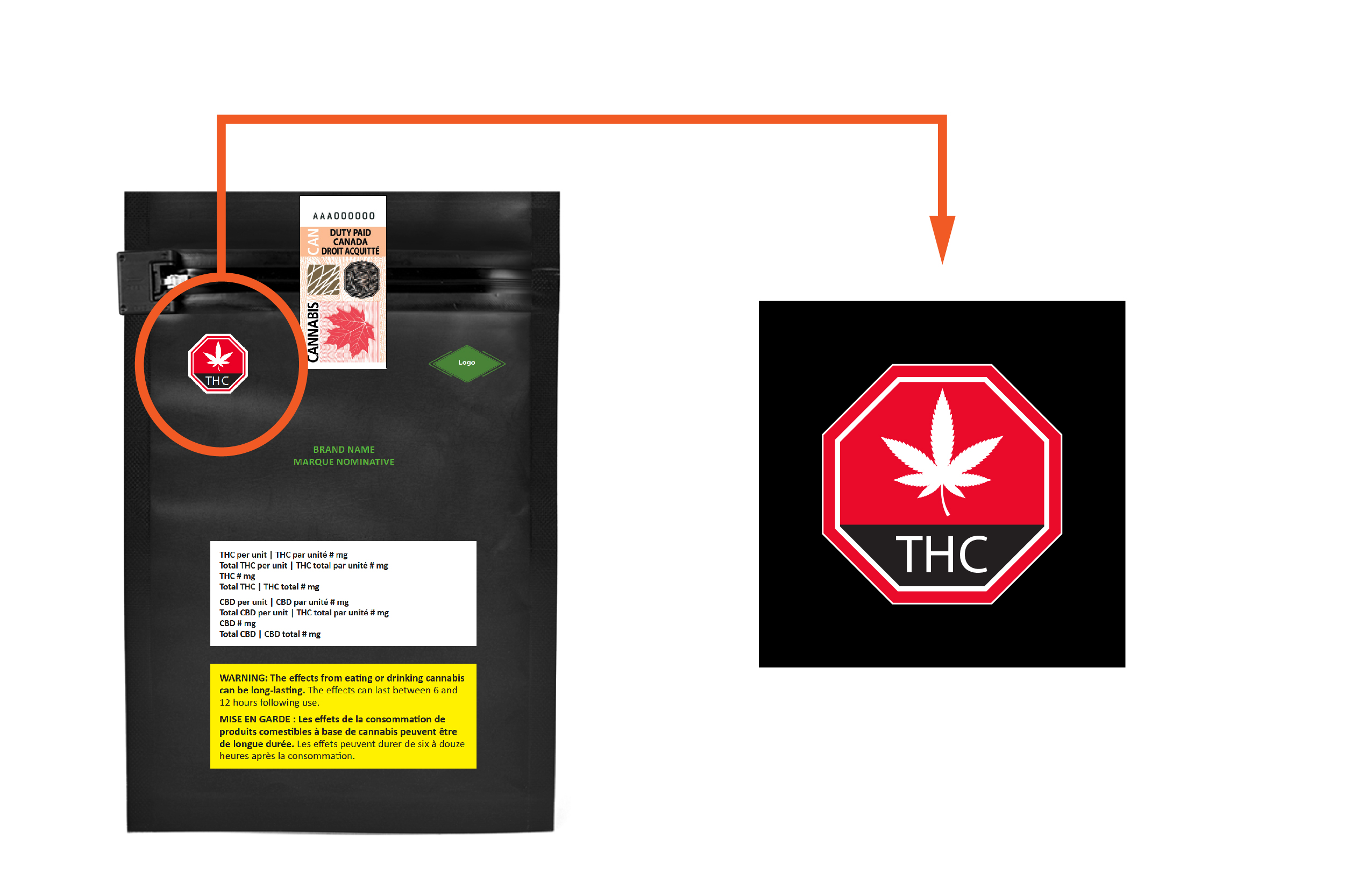
This symbol is required on the front of cannabis products that contain more than 10 micrograms per gram of THC.
-
2. Product brand name and brand element
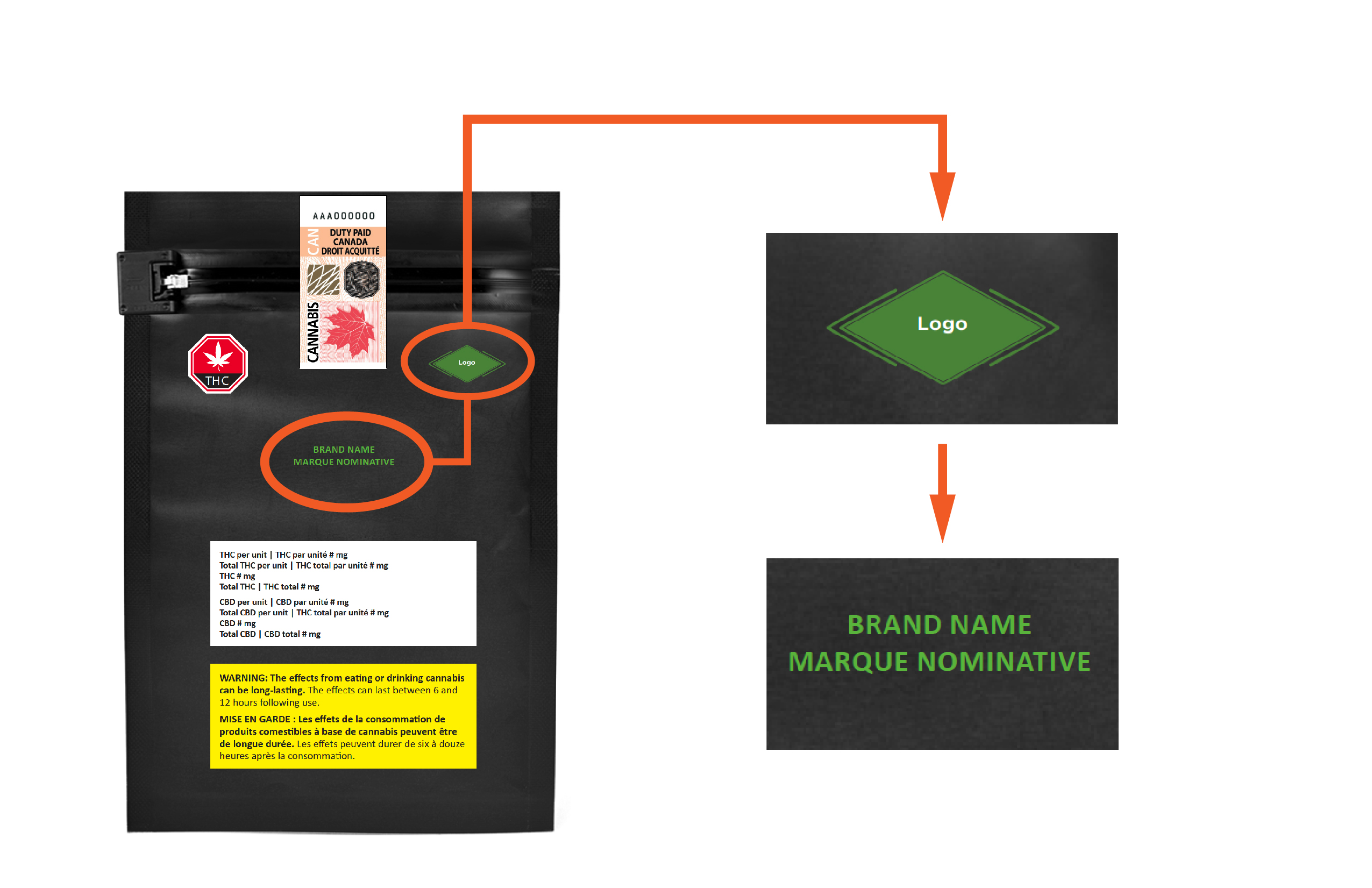
The label needs to have the brand name of the product.
It can also have a small brand element, such as a logo.
-
3. Excise stamp
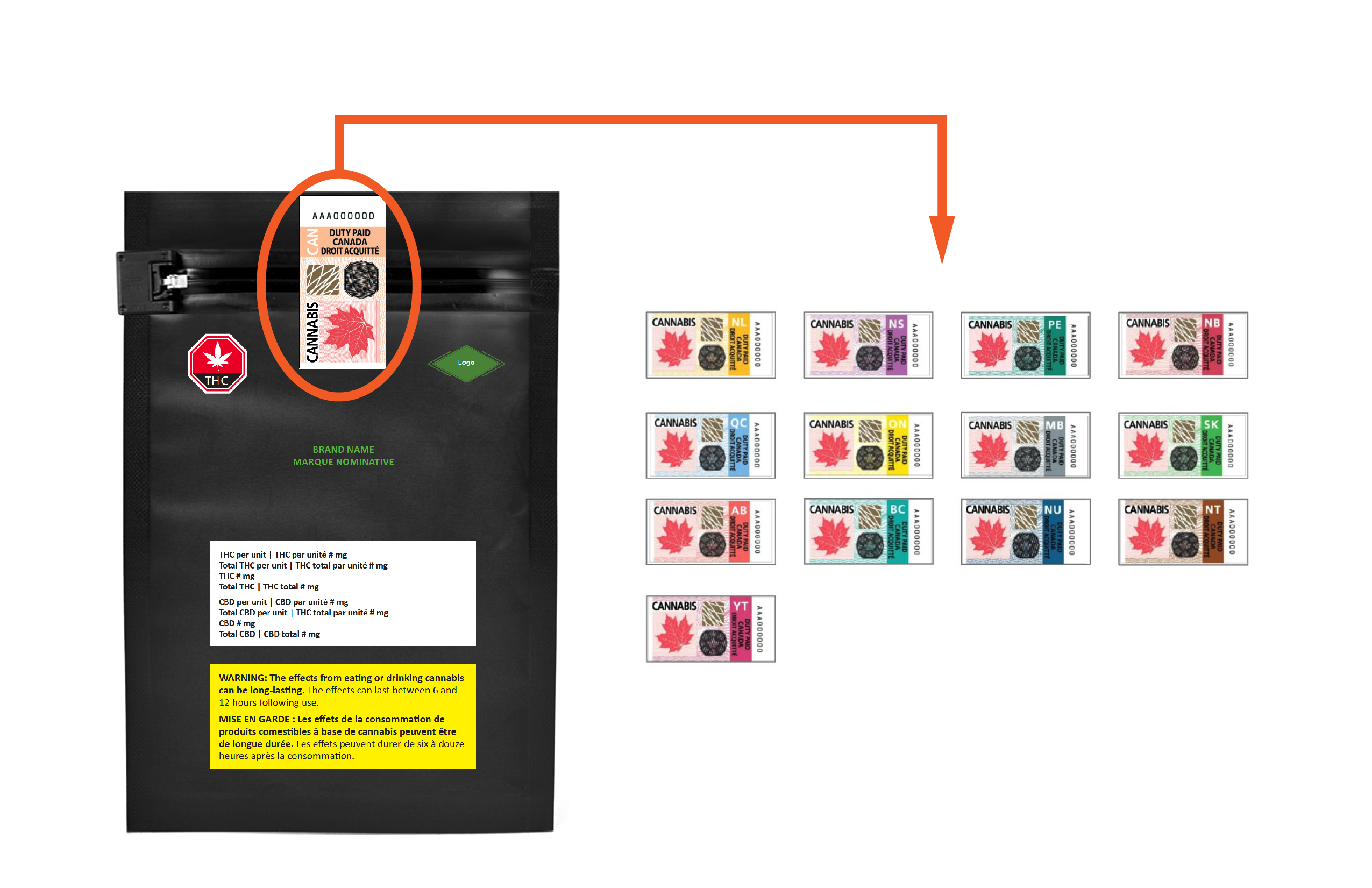
The excise stamp tells you that the product came from a Health Canada licence holder. However, certain low-THC cannabis products or prescription cannabis products don’t need excise stamps. Each province and territory has a different coloured cannabis excise stamp.
-
4. THC and CBD amount
The front of a label needs to have the quantities of THC and CBD in the product as purchased and once activated by heat. Not all cannabis has fully activated THC and CBD content. Dried cannabis and some concentrates may have lower levels of cannabinoids since they haven’t been activated. Other products, such as edible cannabis, will have the same amount since they were activated during production. This is why there are two different amounts of THC and CBD on product labels.
- The first “THC” and “CBD” amounts are the quantity of THC and CBD in the product as purchased.

- “Total THC” and “Total CBD” amounts are the THC and CBD content when the product is used as intended (when all the THC or CBD becomes activated).

The amount of THC and CBD in a product can be presented in different ways. For example:
- Amount by weight: If a 30-gram package of dried cannabis says “THC 180 mg/g”, that means that the entire package contains 5,400 mg of THC (180 mg multiplied by 30 g)
- Amount by unit: If a package of 4 pieces of edible cannabis says “THC per unit 2.5 mg”, it means that the entire package contains 10 mg of THC (2.5 mg multiplied by 4 pieces)
- Total amount: If a package of edible cannabis says “THC 10 mg”, that means that the entire package contains 10 mg of THC
- By activation: If an oral spray says, “Total THC per activation 8 mg”, it means that 8mg of THC will be dispensed per spray
Here’s an example of a cannabis edible THC and CBD amounts. This product:
- contains 5 units
- has the same amount of THC and CBD when purchased and when used as intended
- has 2 mg of THC and 3 mg of CBD per unit
- has a total THC of 10 mg and a total CBD of 15 mg
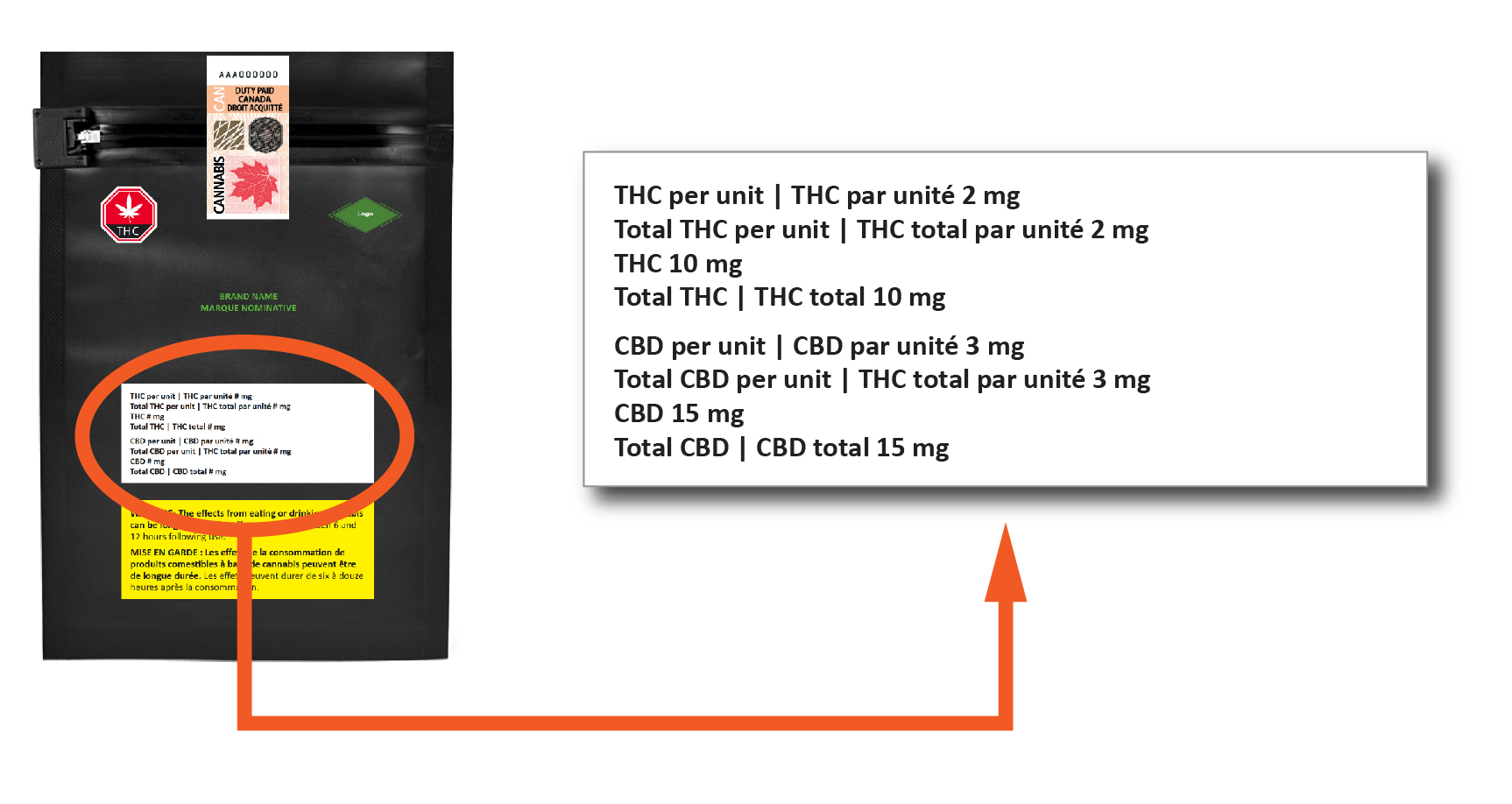
-
5. Health warning message
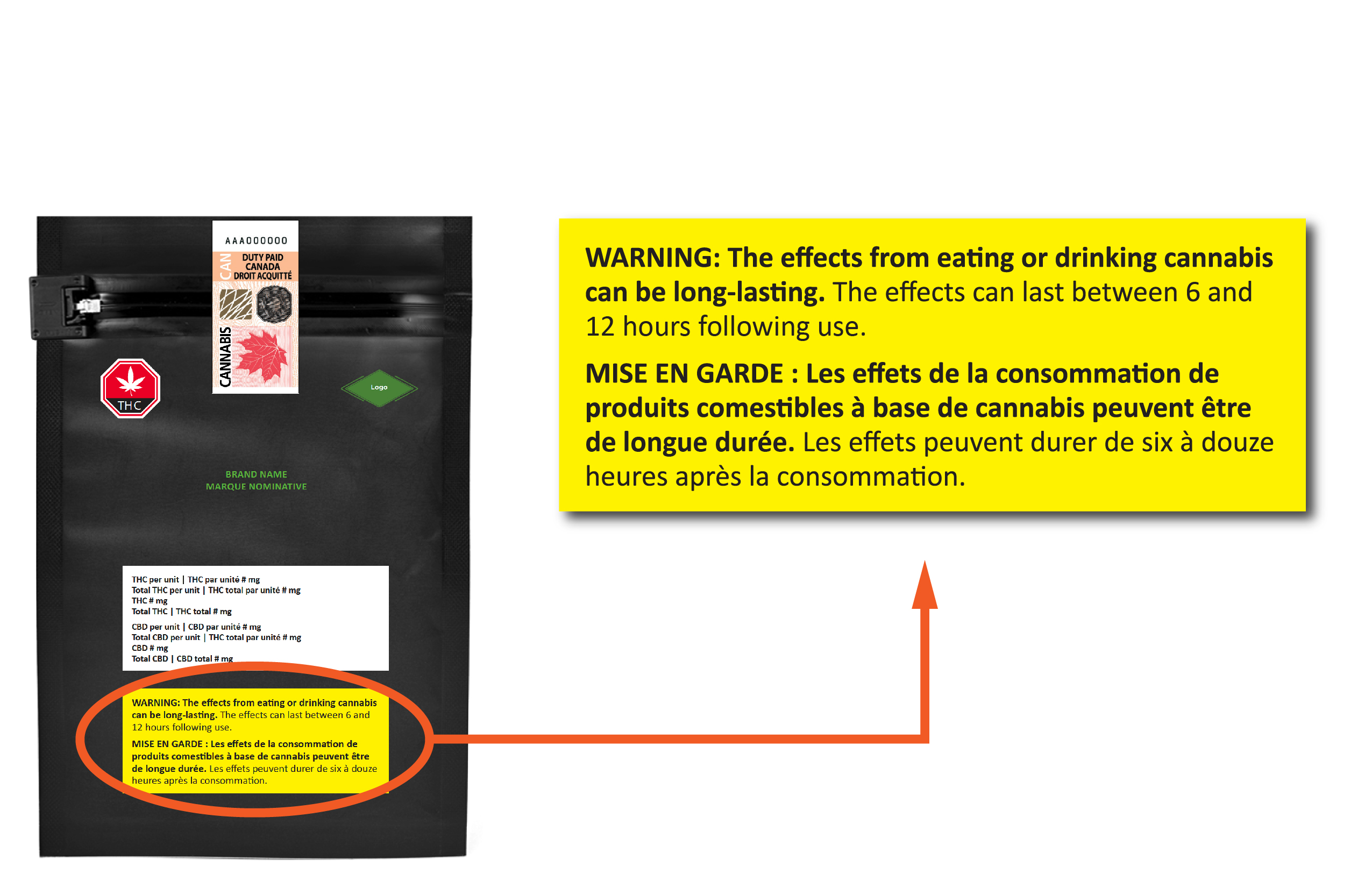
Using cannabis can put your health at risk in ways that we don’t yet fully understand. As such, all cannabis products must have a health warning message in a yellow box on the front of a product label.
There are several health warning messages that include important information about the health risks of cannabis. Health Canada created these based on the most recent scientific research findings on cannabis.
-
6. Other required information
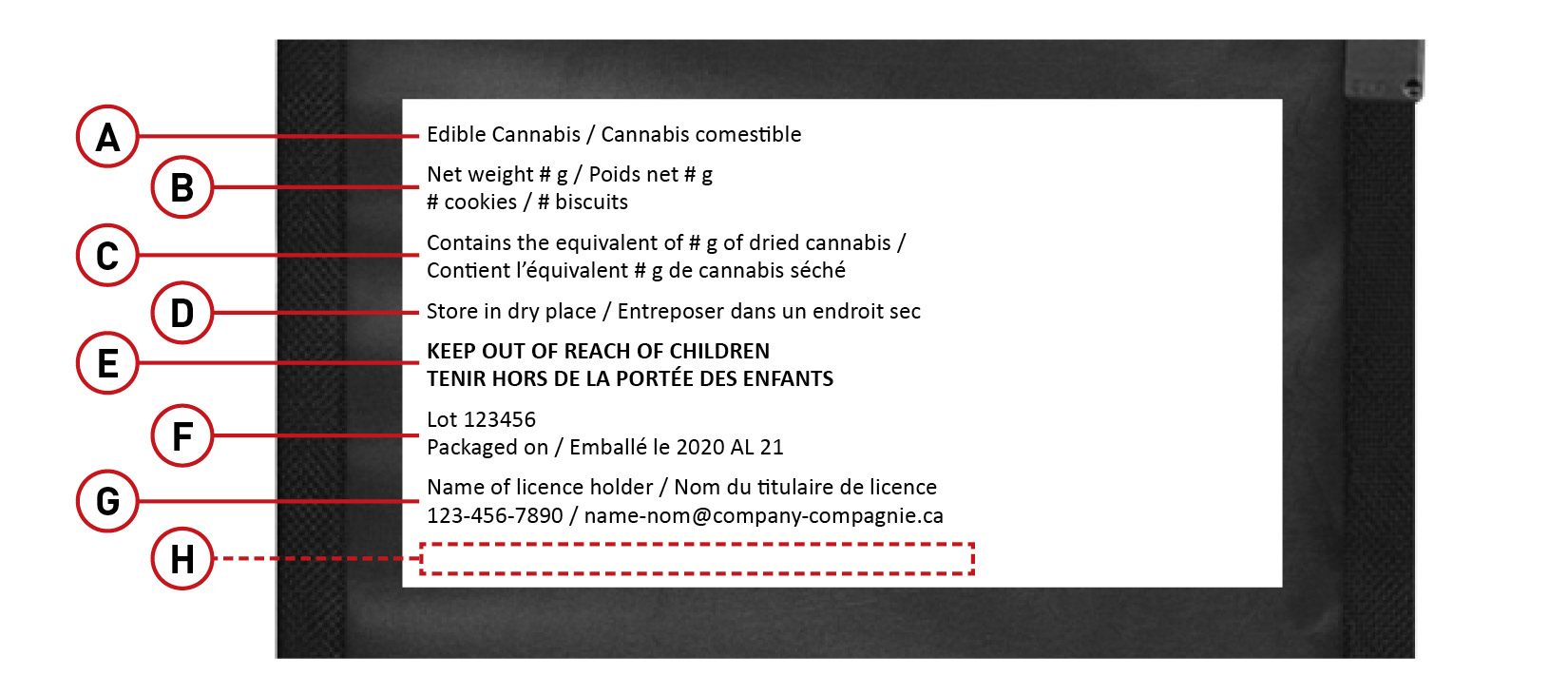
A. Class of cannabis product
The class of cannabis needs to appear on the product label. Classes of cannabis can be:
- dried cannabis (such as dried flower or pre-rolls)
- fresh cannabis
- cannabis plants
- cannabis plant seeds
- edible cannabis (such as candy or beverages)
- cannabis extracts (such as oil, kief or resin)
- cannabis topical (such as creams, ointments or bath bombs)
B. Net weight and number of units
The product label has to contain:
- net weight or volume: this includes the net weight or volume per package and per unit, if applicable
- units: the number of individual pieces found inside the package (such as 10 chocolates, 10 capsules or 10 seeds)
C. Dried cannabis equivalent
This information helps you to determine if you’re within the public possession limit of 30 grams of dried cannabis or its equivalent. This will depend on what form of cannabis you have. 1 gram of dried cannabis is equivalent to:
- 5 grams of fresh cannabis
- 15 grams of solids containing cannabis (such as cannabis chocolate)
- 70 grams of liquids containing cannabis (such as cannabis beverages)
- 0.25 grams of concentrates (such as oil)
- 1 cannabis plant seed
You can use the online possession calculator to help you stay within the possession limit.
D. Recommended storage conditions
The product label needs to indicate recommended storage conditions such as temperature, light conditions or humidity to ensure the product’s quality.
E. Warning statement
All product labels need to indicate “KEEP OUT OF REACH OF CHILDREN / TENIR HORS DE LA PORTÉE DES ENFANTS”.
F. Lot number and packaging date
The product label will contain the lot number and the date when the product was packaged.
G. Contact information
The product label includes the manufacturer's name, telephone number and email address. You can use this to contact them if you have concerns or complaints about:
- a problem or quality issue
- an unwanted side-effect
Include the lot number of the product for reference.
H. Intended use
Some types of cannabis products have a specific intended use that needs to appear on the label:
- dried or fresh cannabis
- cannabis extract
- cannabis topical
The product label includes how it’s intended to be used or consumed (for example, inhalation, ingestion, for use on skin)
-
7. List of ingredients
List of ingredients are required on the product label of:
- cannabis extracts
- cannabis topicals
- edible cannabis
Ingredients are listed in descending order of weight. This means that a product contains more of the first ingredient, and less of the last ingredient on the list of ingredients.
There are additional requirements for certain classes of cannabis, such as:
- cannabis extracts and edible cannabis must list food allergens
- edible cannabis must list the presence of gluten and sulphites
-
8. Nutrition facts table
A nutrition facts table is required on the product label of edible cannabis.
-
9. Optional information
Although not required by Health Canada, the manufacturer can include additional information on the product label, such as:
- how to use the product
- additional warnings or precautions
- expiry date
- cannabis strain name
Cannabis strain names are used by companies to distinguish between products. The strain name doesn’t have any scientific meaning. Sometimes, the strain name refers to the intended effects of the product, however, the effects of cannabis vary from person to person.
Additional resources
Cannabis resource series
- Health effects of cannabis on adults over 55
- Growing cannabis at home safely
- Is cannabis safe to use? Facts for youth aged 13–17 years
- Is cannabis safe to use? Facts for young adults aged 18–25 years
- Does cannabis use increase the risk of developing psychosis or schizophrenia?
- Is cannabis safe during preconception, pregnancy and breastfeeding?
- Is cannabis addictive?
Contact us
Contact Health Canada for the following issues:
- a problem or quality issue through the Cannabis reporting form
- an unwanted side-effect through the Side-effect reporting form
